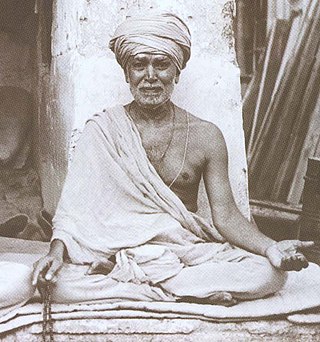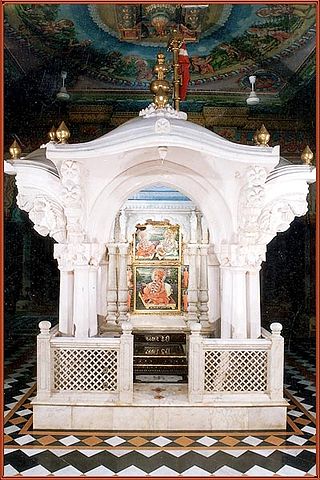
Bochasanwasi Akshar Purushottam Swaminarayan Sanstha is a Hindu denomination within the Swaminarayan Sampradaya. It was formed in 1905 by Yagnapurushdas following his conviction that Swaminarayan remained present on earth through a lineage of gurus starting with Gunatitanand Swami.

Pramukh Swami Maharaj was the guru and Pramukh, or president, of the Bochasanwasi Akshar Purushottam Swaminarayan Sanstha (BAPS), a major branch of the Swaminarayan Sampradaya, a Hindu denomination. BAPS regards him as the fifth spiritual successor of Swaminarayan, following Gunatitanand Swami, Bhagatji Maharaj, Shastriji Maharaj, and Yogiji Maharaj. He was believed by his followers to be in constant communion with Swaminarayan, and ontologically, the manifestation of Akshar, the eternal abode of Swaminarayan.

Yogiji Maharaj, born Jina Vasani, was a Hindu swami and the fourth spiritual successor of Swaminarayan in the Bochasanwasi Akshar Purushottam Swaminarayan Sanstha (BAPS), a major branch of the Swaminarayan Sampradaya. According to the metaphysics of BAPS, Yogiji Maharaj is considered to be the next iteration of Akshar after Shastriji Maharaj in the guru parampara, an unbroken line of "perfect devotees" who provide "authentication of office through Gunatitanand Swami and back to Swaminarayan himself." Together with Pramukh Swami Maharaj, who acted as the administrative head of BAPS, he was instrumental in nurturing the growth of BAPS "through new programs, expansion into new areas, and the construction of temples". As guru, he consecrated over 60 temples and visited over 4000 towns and villages. He was particularly effective in attracting the devotion of youths and initiated a large number of them as ascetics. Furthermore, his multiple tours to Britain and East Africa were integral in the overseas expansion of BAPS. He died on 23 January 1971 after appointing Pramukh Swami Maharaj as his successor.

Gunatitanand Swami, born Mulji Jani, was a prominent paramhansa of the Swaminarayan Sampradaya who was ordained by Swaminarayan and is accepted as the first spiritual successor of Swaminarayan by the Bochasanwasi Akshar Purushottam Swaminarayan Sanstha (BAPS). Born into a religious family in the small farming community of Bhadra in Gujarat, India, he first received religious education under his father's guru, Ramanand Swami before encountering Swaminarayan and becoming a swami under him at the age of 25. He was revered for his spiritual discourses and divine service

The BAPS Shri Swaminarayan Mandir of Houston, Texas is a traditional Hindu temple built by the BAPS Swaminarayan Sanstha. It is in unincorporated Fort Bend County, Texas, within the extraterritorial jurisdiction (ETJ) of Stafford and with a Stafford mailing address.

The BAPS Shri Swaminarayan Mandir of Chicago, Illinois is a traditional Hindu place of worship built by the BAPS Swaminarayan Sanstha. The BAPS Swaminarayan Sanstha, which is headed by Mahant Swami Maharaj, is a denomination of the Swaminarayan Sampradaya within Hinduism. The mandir is located in the Chicago suburb of Bartlett and opened on August 7, 2004. It was built of hand-carved Italian marble and Turkish limestone. The mandir is the largest of its kind in Illinois and was constructed in accordance to the Shilpa shastras. The mandir complex spreads over 27 acres and includes the mandir and the haveli.

Shastriji Maharaj, born Dungar Patel and ordained Shastri Yagnapurushdas, was a swami of the Swaminarayan Sampradaya and founder of the Bochasanwasi Akshar Purushottam Swaminarayan Sanstha (BAPS). Several branches accept him as the third spiritual successor of Swaminarayan in the lineage of Aksharbrahma Gurus through whom Swaminarayan manifests, which began with Gunatitanand Swami. Born in a family of farmers in central Gujarat, India, he became a swami within the Vadtal diocese of the Swaminarayan Sampradaya at the age of 17 where he was given the name Yagnapurushdas Swami. The prefix Shastri was later added in recognition of his eminent scholarship in Sanskrit and the Hindu scriptures. He established BAPS after a doctrinal split from the Vadtal diocese of the Swaminarayan Sampradaya.
Akshar Purushottam Upasana is the BAPS-practice of worshiping Swaminarayan as a supreme being along with Gunatitanand Swami as his ideal devotee. It was formalized by Shastriji Maharaj from the teachings of Swaminarayan when he created the Bochasanwasi Shri Akshar Purushottam Swaminarayan Sanstha (BAPS) in 1907 after leaving the Swaminarayan Sampraday. It could also be referred to as Brahman Parabrahman Upasana or Bhakta Bhagwan Upasana. In this belief, Akshar and Para Brahman are worshiped together, and Para Brahman is present through the living ideal guru on Earth. Followers of BAPS regard Gunatitanand Swami as first the spiritual successor of Swaminarayan and then by Bhagatji Maharaj, Shastriji Maharaj, Yogiji Maharaj, Pramukh Swami Maharaj and Mahant Swami Maharaj..

The BAPS Shri Swaminarayan Mandir in Atlanta, Georgia is a traditional Hindu mandir, or place of worship, inaugurated on August 26, 2007 by the BAPS Swaminarayan Sanstha, a denomination of the Swaminarayan branch of Hinduism headed by Mahant Swami Maharaj. The mandir is located in the Lilburn suburb of Atlanta and was constructed in accordance with the Shilpa shastras, which are ancient Hindu architectural scriptures. It was the largest mandir of its kind outside of India. The mandir is made of 34,450 pieces of hand-carved Italian marble, Turkish Limestone and Indian pink sandstone, and are all situated on over 30 acres of landscaped grounds. The mandir complex also includes a large assembly hall, family activity center, classrooms, and an exhibition on the key tenets of Hinduism.

The BAPS Shri Swaminarayan Mandir in Etobicoke, Toronto, Ontario, Canada is a traditional Hindu place of worship that was built by the BAPS Swaminarayan Sanstha. The BAPS Swaminarayan Sanstha, which is headed by Mahant Swami Maharaj, is a global spiritual organization within the Swaminarayan branch of Hinduism. The mandir was built in 18 months and consists of 24,000 pieces of hand-carved Italian carrara marble, Turkish limestone and Indian pink stone. The mandir is the largest of its kind in Canada and was constructed according to guidelines outlined in ancient Hindu scriptures. The grounds spread over 18 acres and in addition to the mandir, include a haveli and the Heritage Museum. The mandir is open daily to visitors and for worship. On June 26, 2023, the temple celebrated its 16-year anniversary.

The Swaminarayan Sampradaya, also known as Swaminarayan Hinduism and Swaminarayan movement, is a Hindu Vaishnava sampradaya rooted in Ramanuja's Vishishtadvaita, characterized by the worship of its charismatic founder Sahajanand Swami, better known as Swaminarayan (1781–1830), as an avatar of Krishna or as the highest manifestation of Purushottam, the supreme God. According to the tradition's lore, both the religious group and Sahajanand Swami became known as Swaminarayan after the Swaminarayan mantra, which is a compound of two Sanskrit words, swami and Narayan.

The Swaminarayan mantra, "Swaminarayan," is a mantra used by the Swaminarayan Sampradaya. It is a compound of two words: Swami and Narayan, that is, Vishnu c.q. Purushottam. According to the Swaminarayan-tradition, the Swaminarayan Mantra was introduced and explained by Swaminarayan, also known as Sahajanand Swami, spiritual head of the Swaminarayan Sampradaya, shortly after the death of his predecessor, Ramanand Swami. Devotees chant the Swaminarayan mantra to offer worship, to allay distress, to pray for the welfare of others, and at the end-of-life. Several scriptures of the Swaminarayan Sampradaya, such as the Swamini Vato, Harililamrut, and Bhaktachintamani, describe the power and efficacy of the Swaminarayan mantra for one who chants it.
Bhagatji Maharaj, born as Pragji Bhakta, was a householder devotee in the Swaminarayan Sampradaya, a Hindu denomination. He is regarded as the second spiritual successor of Swaminarayan in the Bochasanwasi Akshar Purushottam Swaminarayan Sanstha (BAPS).

The BAPS Shri Swaminarayan Mandir is a Hindu temple complex located in Chino Hills, in southwestern San Bernardino County in southern California. The temple belongs to the Bochasanwasi Akshar Purushottam Swaminarayan Sanstha denomination of Hinduism. However, the BAPS Shri Swaminarayan Mandir is open to visitors of all faiths.

The Akshar Deri is a major site of pilgrimage in the Swaminarayan Sampradaya and is located in the rang mandap of the BAPS Swaminarayan temple in Gondal, India. The structure marks the cremation site and serves as a memorial to Gunatitanand Swami. An event was held to commemorate 150 years of the structure in Gondal, the structure as well as the site was renovated to bring it to modern standards.
The BAPS Shri Swaminarayan Mandir Christchurch is the third mandir in New Zealand of the Bochasanwasi Akshar Purushottam Swaminarayan Sanstha (BAPS). It is the only Hindu temple on the South Island of New Zealand. It officially opened on 26 June 2012.

Swaminarayan Akshardham in Robbinsville, New Jersey, U.S., is a Hindu mandir (temple) complex. The BAPS Shri Swaminarayan Mandir, one component of the campus, was inaugurated and opened to the public on August 10, 2014. The Akshardham in Robbinsville was then expanded and re-inaugurated on October 8, 2023, and is the world’s second-largest Hindu temple and the largest outside Asia.

Mahant Swami Maharaj is the present guru and president of the Bochasanwasi Akshar Purushottam Swaminarayan Sanstha (BAPS), a major branch of the Swaminarayan Sampradaya, a Hindu denomination. BAPS regards him as the sixth spiritual successor of Swaminarayan, following Gunatitanand Swami, Bhagatji Maharaj, Shastriji Maharaj, Yogiji Maharaj, and Pramukh Swami Maharaj. He is believed by his followers to be in constant communion with Bhagwan Swaminarayan, and ontologically, the manifestation of Akshar, the perfect devotee of God.

The BAPS Hindu Mandir Abu Dhabi in UAE, is a traditional Hindu place of worship that is being built by the BAPS Swaminarayan Sanstha. The site is located at Abu Mureikhah, which is near Al Rahba off the Dubai–Abu Dhabi Sheikh Zayed Highway. The mandir, upon completion, will be the first traditional Hindu stone mandir in the Middle East. The BAPS Swaminarayan Sanstha, which is headed by Mahant Swami Maharaj, is a denomination of the Swaminarayan branch of Hinduism. The mandir, inspired by Pramukh Swami Maharaj and blessed by Mahant Swami Maharaj, will be situated on 55,000 square meters of land. The mandir will be hand-carved by artisans in India and assembled in the UAE. The mandir will incorporate all aspects and features of a traditional Hindu mandir as part of a fully functional, social, cultural and spiritual complex. The complex will include a visitor center, prayer halls, exhibitions, learning areas, sports area for children, thematic gardens, water features, a food court, a books and gift shop.

Akshar-Purushottam Darshan or Aksarabrahma-Parabrahma-Darsanam, "Akshar-Purushottam philosophy," is a designation used by BAPS as an alternative name for the Swaminarayan Darshana, Swaminarayan's view or teachings, to distinguish it from other Vedanta-traditions. It is based on Swaminarayan's distinction between Parabrahman and Aksharbrahman as two distinct eternal realities, which in this view sets Swaminarayan's teachings apart from other Vedanta-traditions. It is an essential element for the BAPS and it's Akṣara-Puruṣottama Upāsanā ("worship"), in which Purushottam c.q. Parabrahman is present in a lineage of Aksharbrahman guru's, who are the abode (akshar) of God.


















